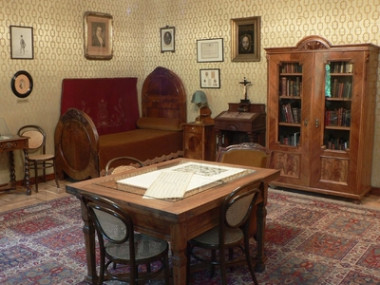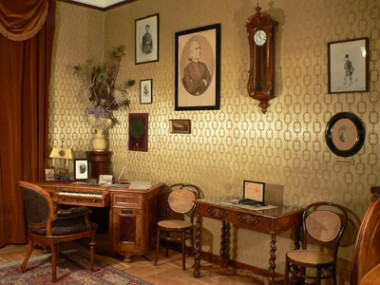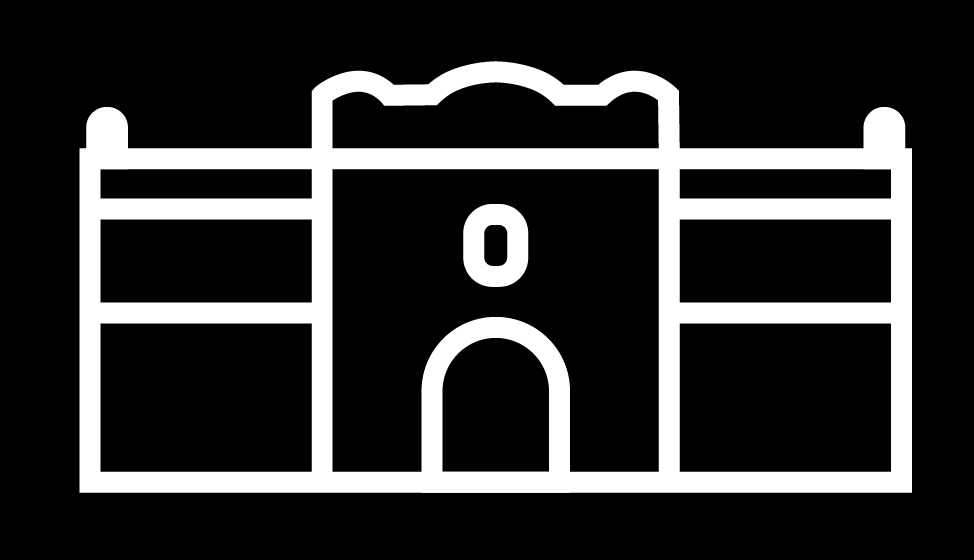Study bedroom
On the basis of a picture published in one of the 1886 issues of the journal "Magyar Szalon" (Hungarian Salon), together with other descriptions it was possible to reconstruct the study-bedroom of his flat most like the original. Liszt obviously found some calm here, if he needed some rest, and here he composed the works of his last years.

Ludwig Boesendorfer (1835-1919) was a personal friend of Liszt, as is proved by unique evidence in the Budapest estate; namely a two-door writing desk, with 3 drawers made of walnut. In the place of the middle drawer, there is a small pull-out piano with three-octave keyboard. This composing-desk with piano, "a splendid work of art, which decorated both the study-bedroom and the dining room, on which the name Boesendorfer will soon be engraved, this name, which is so benign for me..." /30.1.1877, Liszt/ thanked Liszt in his letter to the donor. The small instrument, in which the miniature hammers, which are supplied with sound-dampers as well, strike fixed metal-sheets. Actually it is rather a curiosity. It is only useful to check chords, fingering or any kind of passage or rapid scales, during composing. Its soft sound could hardly disturb Ferenc Erkel, who as the director of the Academy of Music lived for some years above the study-bedroom of Liszt. Boesendorfer's gift is unique, we know of no other writing desk like this one.
The small table is very similar to the one which stood here at one time. On it is placed the bronze replica of Liszt's right hand, made by Alajos Strobl. The programme on the table with a drawing of Liszt by Munkacsy is that of Liszt's concert on 23.3.1886 in Paris at the palace of Mihaly Munkacsy.
The drapery behind the bed is from the Liszt estate, though originally there hung here another tapestry embroidered by Princess Carolyne Sayn-Wittgenstein.The original bedcloth was also her work, but we have no information about their whereabouts. The picture above the bed is the painting by Alajos Gyorgyi Giergl,which portrays the daughter of Liszt, Cosima Bülow. The circumstances of its origin are unknown. The praying desk was made for the flat at Sugar ut, it was designed by Sandor Fellner. Most probably the crucifix was presented by Princess Carolyne Sayn-Wittgenstein. On the praying desk of Liszt can be seen both his prayer book and his rosary. The glass cabinet was also in the flat at Sugar ut, with Liszt's library in it, which he left to the Academy of Music. In the other glass case we keep some of his scores. Both the books and the scores, about which a detailed catalogue has been published, contain several important markings and inscriptions by Liszt and bear the impress of the stamp of the estate.

The glass-piano of Liszt - even if not the only instrument like this - is a curiosity. It was made by Georges Bachmann, who had a factory in Tours and in Angers. He called his invention piano-harmonica, introducing it in l865, though not without any precedents in the history of instruments. It had a range of 4 octaves (c1-c5) with piano action. Instead of strings there are glass plates. We don't know either the year when Liszt's instrument was manufactured - it doesn't bear a serial number - or the time when he obtained it. Nevertheless, in 1872 it was in the safe-keeping of Boesendorfer, and Liszt asked that the small instrument, named by him as "joujou d'harmonica en verre", should, together with the Chickering piano of 1867, go to Szekszard, where it would be near the huge instrument like the small dog in the lions-house. It was Bachmann's score entitled "Fête des Nymphes" which gave the idea of this connection, which was personally dedicated to Liszt by Bachmann and which contains a duettino written for a piano-harmonica and piano.
The instrument became the property of the Academy of Music in 1887. Above the glass piano on the wall can be seen portraits of Liszt's relatives.



